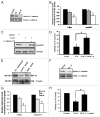Inhibition of lung cancer cells growth, motility and induction of apoptosis by Klotho, a novel secreted Wnt antagonist, in a dose-dependent manner
- PMID: 22922788
- PMCID: PMC3469480
- DOI: 10.4161/cbt.21420
Inhibition of lung cancer cells growth, motility and induction of apoptosis by Klotho, a novel secreted Wnt antagonist, in a dose-dependent manner
Abstract
Klotho (KL) is a transmembrane protein that can be shed, and act as a circulating hormone and modulate several signaling pathways. There also exists a splice variant of Klotho mRNA, which encodes a putative secreted protein (Klotho-S, KL-S) in both human and mouse. The potential anti-senescence gene Klotho has been recently found to participate in the progression of several different human cancers. In the current study, we undertook to study the expression and activity of Klotho in lung cancer cell line A549. Klotho expression was studied by using RT-PCR and western blotting. Effects of Klotho on cell growth and motility were assessed using MTT and scratch motility assay, and the apoptosis was assessed by TUNEL. Wnt signaling pathway activity was measured by western blotting. We established that the Klotho was endogenous expressed in A549 cells, but the expression level is lower compared with normal lung tissues. The overexpression of KL or KL-S could inhibit the cell proliferation, motility, and induce apoptosis in a dose-dependent manner. Also, we report KL could inhibit activation of Wnt -TCF/β-catenin signaling pathway, and it is involved in KL-induced growth inhibition. These studies indicate Klotho works as a potential tumor suppressor in lung cancer, and suggest that the Klotho tumor suppressive activities could be mediated through its KL-S isoform. These results suggest the use of Klotho or KL-S as potential strategy for the development of novel therapeutic interventions for lung cancers.
Figures






Similar articles
-
Overexpression of Klotho suppresses liver cancer progression and induces cell apoptosis by negatively regulating wnt/β-catenin signaling pathway.World J Surg Oncol. 2015 Oct 24;13:307. doi: 10.1186/s12957-015-0717-0. World J Surg Oncol. 2015. PMID: 26499380 Free PMC article.
-
Klotho inhibits growth and promotes apoptosis in human lung cancer cell line A549.J Exp Clin Cancer Res. 2010 Jul 19;29(1):99. doi: 10.1186/1756-9966-29-99. J Exp Clin Cancer Res. 2010. PMID: 20642846 Free PMC article.
-
KL1 internal repeat mediates klotho tumor suppressor activities and inhibits bFGF and IGF-I signaling in pancreatic cancer.Clin Cancer Res. 2011 Jul 1;17(13):4254-66. doi: 10.1158/1078-0432.CCR-10-2749. Epub 2011 May 13. Clin Cancer Res. 2011. PMID: 21571866
-
Molecular basis of Klotho: from gene to function in aging.Endocr Rev. 2015 Apr;36(2):174-93. doi: 10.1210/er.2013-1079. Epub 2015 Feb 19. Endocr Rev. 2015. PMID: 25695404 Free PMC article. Review.
-
The interplay of Klotho with signaling pathway and microRNAs in cancers.J Cell Biochem. 2019 Sep;120(9):14306-14317. doi: 10.1002/jcb.29022. Epub 2019 May 24. J Cell Biochem. 2019. PMID: 31127658 Review.
Cited by
-
Revealing the tumor suppressive sequence within KL1 domain of the hormone Klotho.Oncogene. 2024 Jan;43(5):354-362. doi: 10.1038/s41388-023-02904-2. Epub 2023 Dec 1. Oncogene. 2024. PMID: 38040805
-
Genetic Liability to Insomnia and Lung Cancer Risk: A Mendelian Randomization Analysis.Front Genet. 2021 Dec 1;12:756908. doi: 10.3389/fgene.2021.756908. eCollection 2021. Front Genet. 2021. PMID: 34925448 Free PMC article.
-
Antiaging gene Klotho regulates epithelial-mesenchymal transition and increases sensitivity to pemetrexed by inducing lipocalin-2 expression.Oncol Lett. 2021 May;21(5):418. doi: 10.3892/ol.2021.12679. Epub 2021 Mar 28. Oncol Lett. 2021. PMID: 33841579 Free PMC article.
-
Overexpression of Klotho suppresses liver cancer progression and induces cell apoptosis by negatively regulating wnt/β-catenin signaling pathway.World J Surg Oncol. 2015 Oct 24;13:307. doi: 10.1186/s12957-015-0717-0. World J Surg Oncol. 2015. PMID: 26499380 Free PMC article.
-
Association of Klotho Gene Polymorphism and Serum Level of α Klotho Protein with Different Tumor Grades, Overall Survival and Cytokine Profile in Glioma Patients.Int J Mol Sci. 2025 Jan 2;26(1):330. doi: 10.3390/ijms26010330. Int J Mol Sci. 2025. PMID: 39796185 Free PMC article.
References
-
- He B, Jablons DM. Wnt signaling in stem cells and lung cancer. Ernst Schering Found Symp Proc. 2006:27–58. - PubMed
Publication types
MeSH terms
Substances
LinkOut - more resources
Full Text Sources
Other Literature Sources
Medical
Molecular Biology Databases
